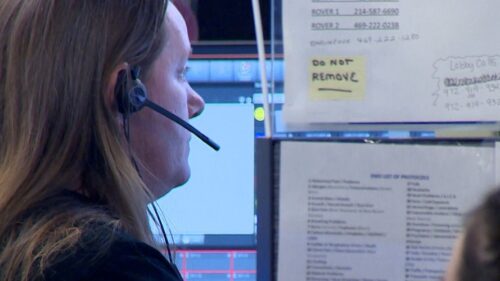
8.31.23 – WFAA-TV – CARROLLTON, Texas
The program provides 911 callers the ability to share a livestream of their surroundings with dispatch.
The North Texas Emergency Communications Center (NTECC) recently rolled out new technology that is designed to help dispatchers better understand emergency calls they receive.
Terry Goswick, executive director of NTECC, calls it state-of-the-art technology.
“It gives us the ability to send them a text, they can opt in, and if they want to share their screen with us, share their video live at the scene with us – they can do that,” Goswick said.
The new program, Prepared 911, provides callers the ability to share a livestream of their surroundings with dispatch.
Right now, it is only available in Carrollton, Addison, Coppell and Farmers Branch.
Goswick said Prepared 911 provides context to a dispatcher and helps determine what kind of resources are needed at the scene. He said this is helpful in situations where callers are scared, are in distress, and may have a hard time formulating a sentence.
“Most people when they call us, it’s on the worst day of their life,” Goswick said.
Here’s how it works; A 911 caller is sent a text message with a link. That link allows the dispatcher to access the caller’s camera. Just like a FaceTime call, dispatch will see what you see, including yourself if you flip the camera around. The video is recorded and used to better asses what type of response is needed to the emergency.
A dispatcher’s access to a caller’s camera is disconnected when the call ends. Police can use the video for evidence in the future, if necessary. Callers do not have access to the recorded video.
Goswick said he understands any skepticism.
Prepared 911 is not an app and callers do not need to download anything. Dispatchers, first responders, or other city entities cannot access a caller’s data before, during, or after a call or sharing live video.
Goswick said his concern was for the mental well-being of his call-takers.
“They’re call-takers. They’re used to hearing it on the phone,” said Goswick. “They’re not usedt to seeing it. We’ve had significant concern about that.”
NTECC has provided dispatchers with mental health services and learning sessions to cope with what they may witness when callers call in a crisis. He said if something is too disturbing for one call-taker, they can blur the screen and another dispatcher can immediately take over.
Goswick said Prepared 911 can be used for all different types of calls.
“[It’s] best used for active shooter situations, large fires, automobile accidents that are on the interstate,” Goswick said. “It lets us know what lanes of traffic are being blocked. And sometimes, people don’t even know where they are.”
Prepared 911 is equipped with more specific and narrowed-down details of where a person is.
Prepared 911 can be utilized between any 911 caller and dispatcher so long as the caller has service where they are calling from.
